
|
As the world begins to reopen after the COVID-19 pandemic, many are hoping for life to return to normal. Fewer restrictions are allowing people to act more freely and resume more normal activities, which is generally good for business owners who have felt the strain of the pandemic more than many. But just when returning customers and reinvigorated sales are helping businesses and restaurants bounce back from pandemic lows, a new challenge has arisen: a labor shortage.
Companies across the nation are struggling to fill open positions as demand for labor surges. Smaller companies, in particular, are feeling the pinch with fewer employees to pick up the slack and fewer resources to compete with behemoth employers like Amazon. To understand how businesses are handling this hiring shortage, we surveyed over 500 business owners and hiring managers. We asked them about the current state of their business and how the labor shortage has impacted them. We also learned what strategies businesses have had the most success with in combating a labor shortage. Read on to see what we discovered.
To better understand the current small-business landscape, we asked respondents how their businesses performed in various areas before the pandemic, amid the pandemic, and currently.
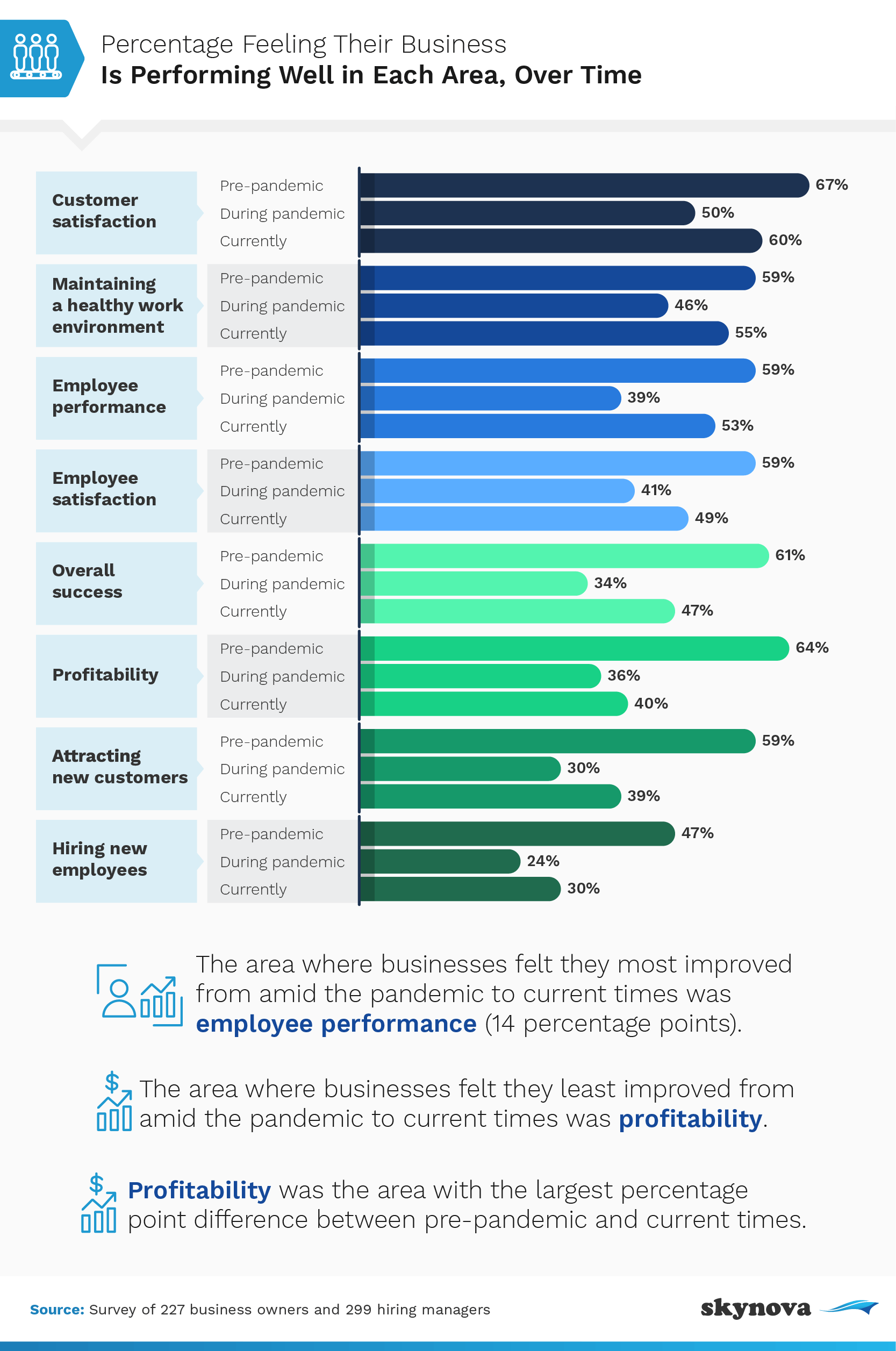
The area where businesses saw the greatest improvement between the middle of the pandemic and now was employee performance, which increased by 14 percentage points after a 20-point drop during the pandemic.
The greatest challenge during the pandemic appears to have been attracting new customers. Only 30% of respondents said their business was performing well in regards to attracting new customers during the pandemic, compared to 59% of businesses pre-pandemic. This was despite the creative ways businesses adapted their marketing during the COVID-19 pandemic. Now that number is up to 39% of businesses, so there’s still a long way to go.
Other significant changes occurred in overall success, which fell by 27 percentage points during the pandemic, and the number of businesses reporting good profitability, which fell by 28 points during the pandemic. Since then, the number of businesses that rate their overall success as performing well has risen to 47%, but the percentage of businesses who rate their profitability favorably currently remains at only 40%, a mere four percentage points higher than during the pandemic. This is the largest percentage point difference between pre-pandemic and current levels in terms of the number of business owners who feel their business is doing well in that respect.
Part of the reason small businesses may be continuing to struggle in terms of profitability and overall success is the challenge of finding new employees. Business owners’ views of employee hiring rose by only six percentage points since pandemic lows, suggesting the labor shortage is real. The inability to fill open jobs may be impacting sales.
Business owners’ optimism varied, but most business owners were at least a little optimistic about their business currently. Over 1 in 5 businesses were extremely optimistic, and 37% reported being very optimistic.
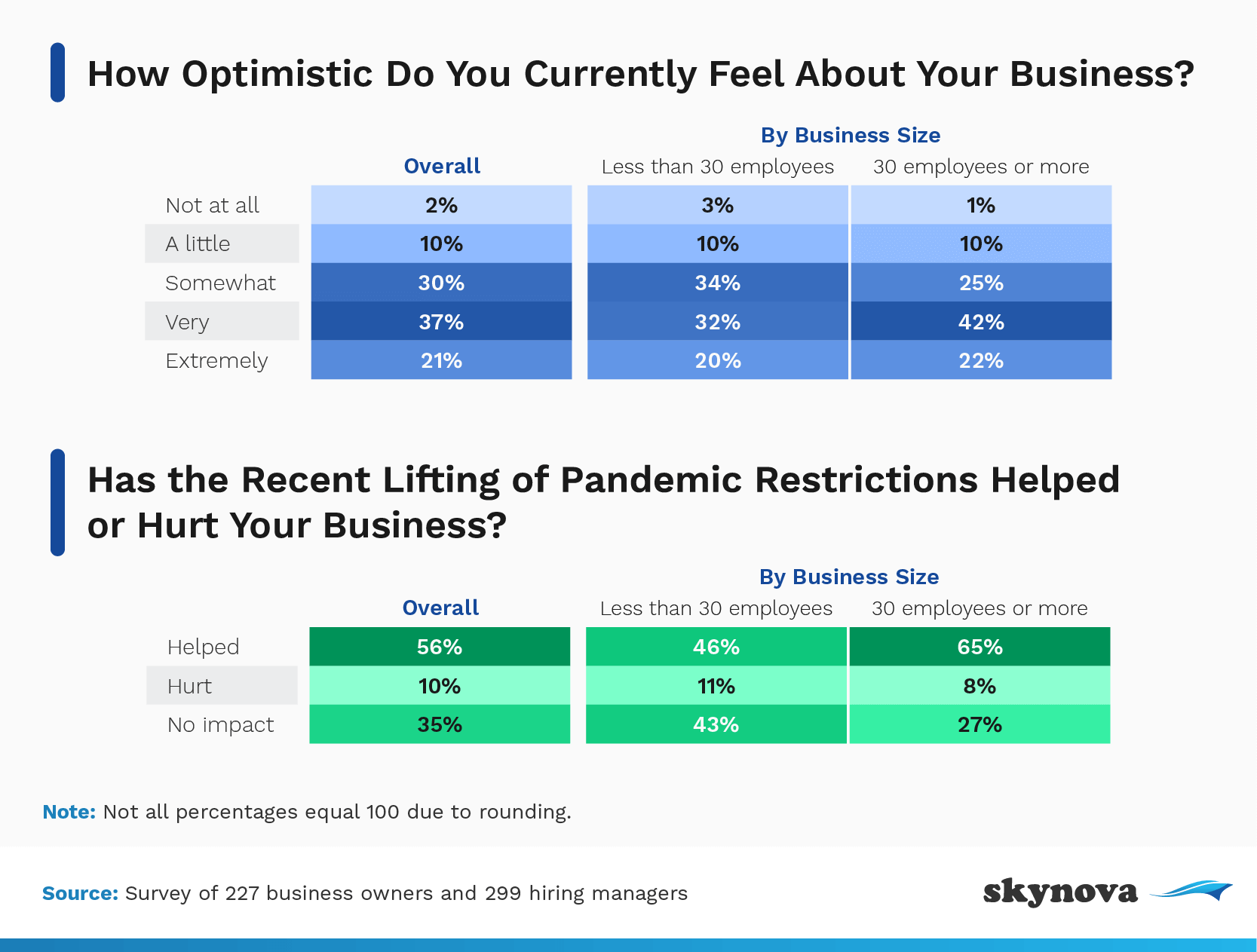
Owners with larger businesses (e.g., those with 30+ employees) were more optimistic than smaller businesses. Sixty-four percent of business owners with 30 or more employees were very or extremely optimistic currently, compared to only 52% of business owners with less than 30 employees. Business owners with 30 or more employees were far more likely to say the easing of restrictions helped their business, compared to owners with less than 30 employees.
Even as the economy starts to slowly bounce back from a tough pandemic year, there are still challenges. Over half of the business owners and managers surveyed said they’re currently experiencing a labor shortage.
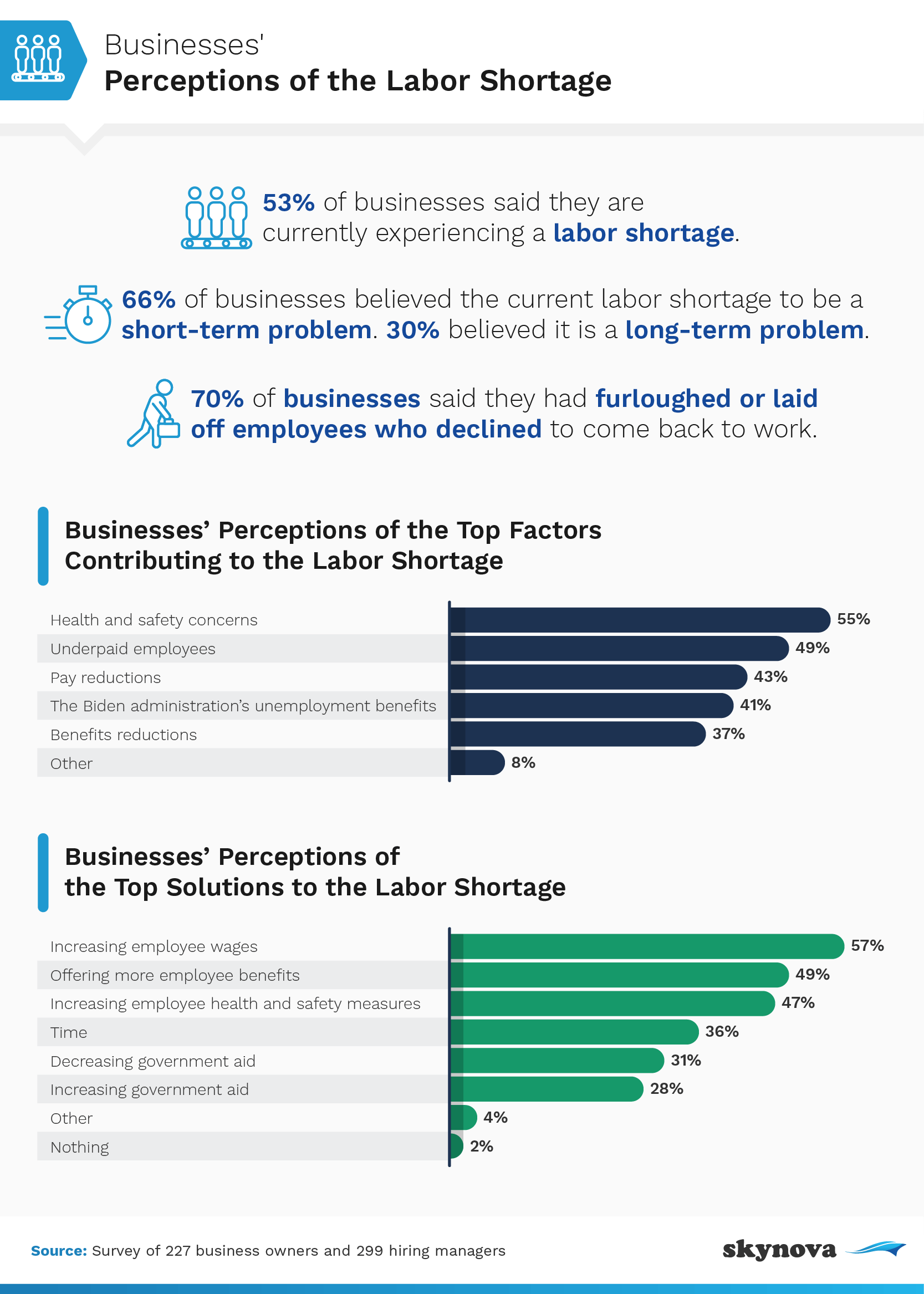
Part of the challenge is some furloughed or laid-off employees may refuse to come back to work. Seven in 10 business owners said they’ve had furloughed or laid-off employees decline to return. The reasons for this could be manifold, from unemployment benefits that are higher than their usual wages to health and safety concerns or new job opportunities elsewhere.
According to our survey, health and safety concerns were the primary factor business owners and managers believed to be contributing to the labor shortage (55%), with businesses not paying employees enough being the second-most commonly cited factor (49%).
Despite these challenges, 66% of businesses said they believe the current labor shortage is a short-term problem. Their top solutions to rectify the labor shortage included paying higher wages, which 57% ranked as a top solution. The second-most popular solution was to offer more employee benefits. Even though only 37% of businesses cited reductions in benefits as a top contributing factor to the labor shortage, nearly 50% of business owners viewed increasing employee benefits as a viable solution.
Improving health and safety measures for employees was another top solution, according to 47% of business owners. However, according to 36% of business owners, a top solution was simply to give it time. More than 3 in 10 small-business owners told the U.S. Census Bureau they thought it’d take more than six months for business to return to normal.
Experts say that if left unchecked, the current labor shortage could turn into the worst labor shortage in 50 years. Such a shortage could have drastic impacts on businesses, many of whom are already feeling the strain of underemployment.
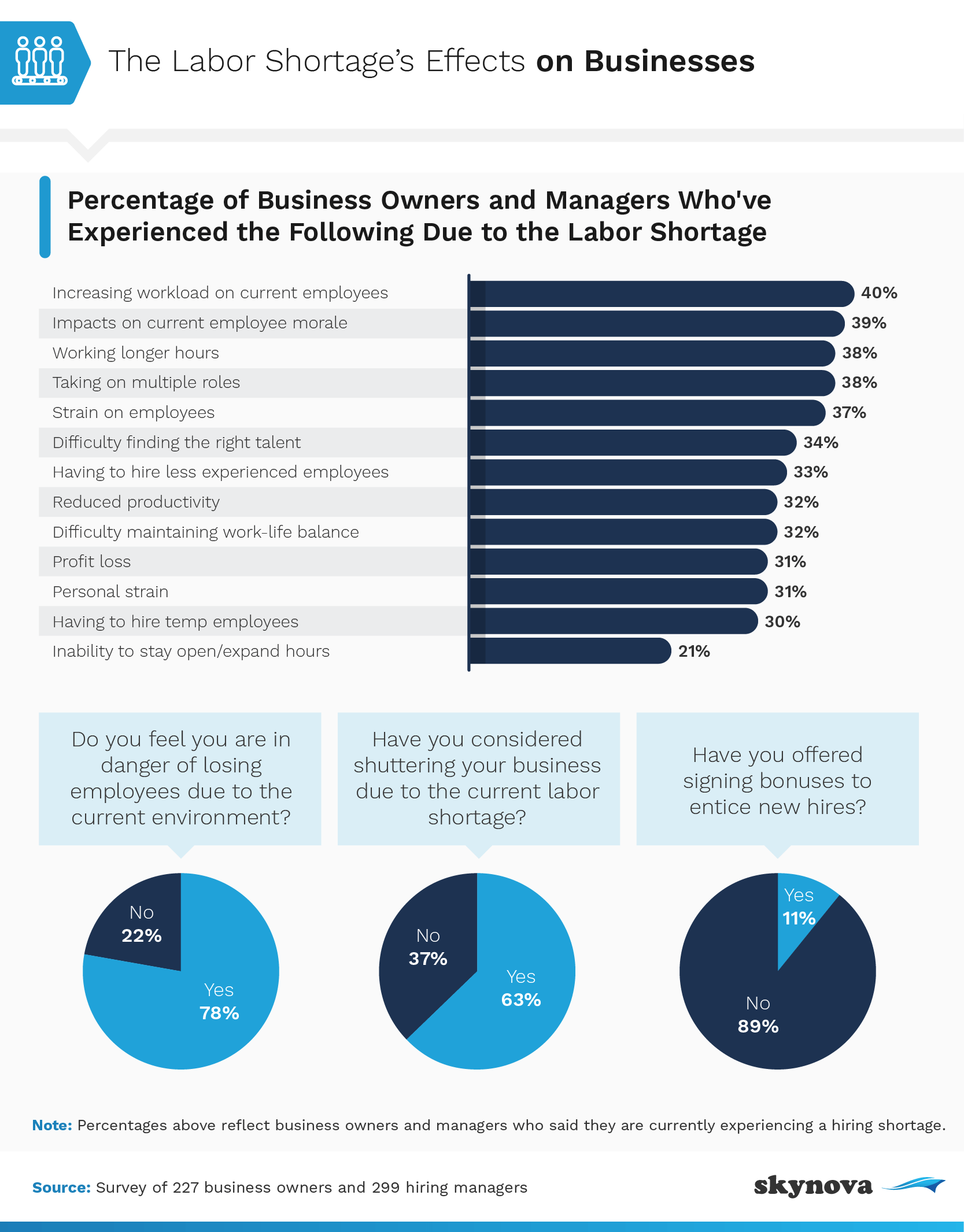
The most common consequence businesses had experienced due to the current labor shortage was an increased workload on current employees. Nearly the same number said the labor shortage has impacted employee morale. Business owners and hiring managers are having to work longer hours and wear multiple hats because of the labor shortage, which is causing personal strain aside from the strain placed on employees.
For around one-third of business owners, finding the right talent has proven challenging because of the labor shortage. One-third of small businesses said they have had to hire employees with less experience due to the shortage, and 3 in 10 said they’ve had to hire temp employees to fill empty positions.
All of this can cause a drop in productivity and profitability, which 32% and 31% of business owners had experienced, respectively. A labor shortage also makes it challenging to maintain a work-life balance and puts a strain on business owners who may be forced to cut hours, as 21% of respondents said they’ve needed to do.
To make matters worse for businesses, 78% of business owners said they feel like they’re in danger of losing even more employees due to the current environment. Nearly two-thirds had considered closing their business for good because of the labor shortage. In an effort to remedy the problem, about 1 in 10 business owners have offered signing bonuses to entice new hires to join their firm.
While there is much debate about how to fix the current labor shortage, with many saying the government will need to take action, businesses aren’t without recourse. We asked survey respondents how they’ve dealt with labor shortages both currently and in the past to uncover actionable steps businesses can take to help rectify their current shortage.
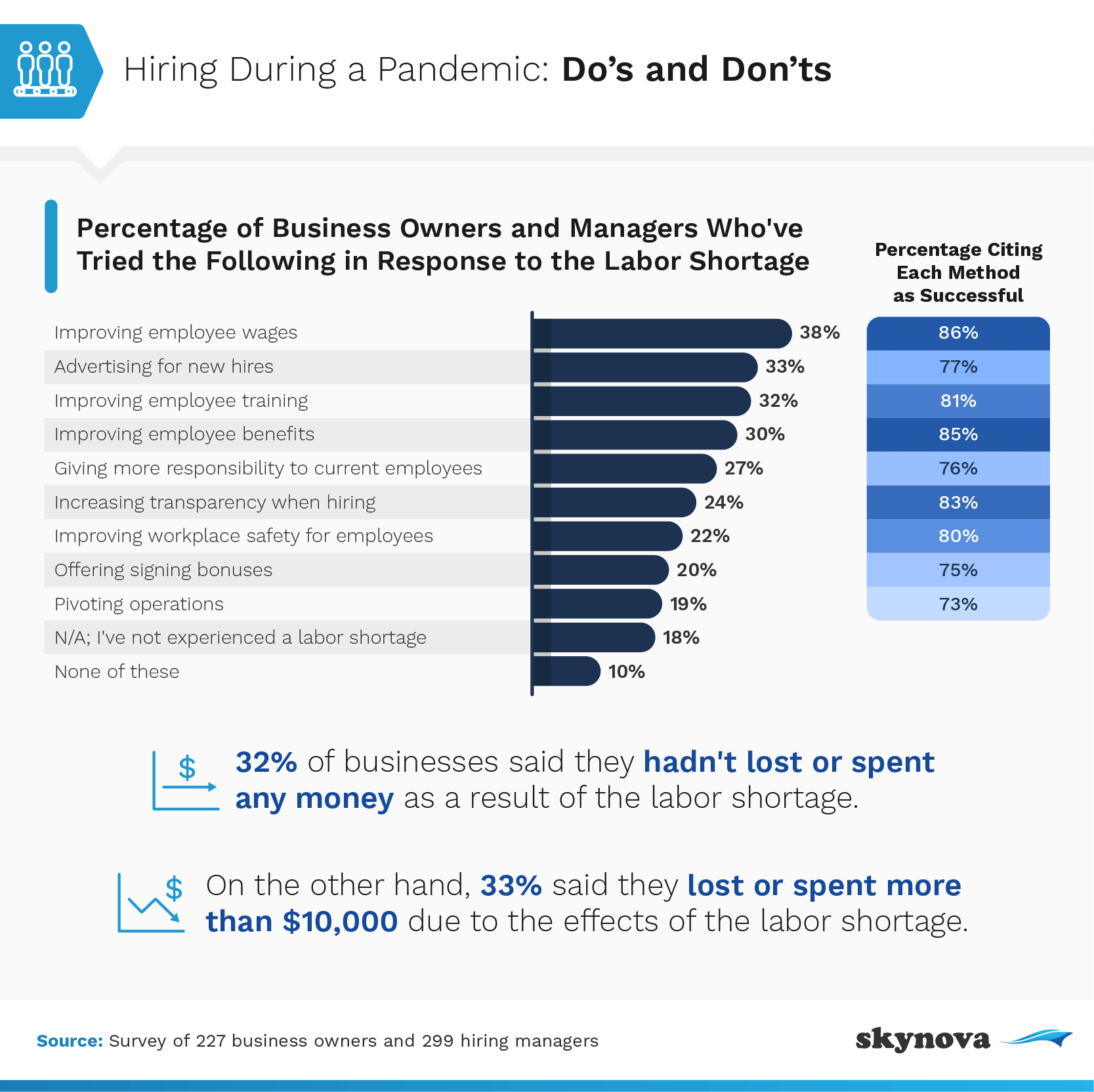
The most successful response to a labor shortage business owners have experienced is in improving employee wages. Of the 38% of business owners who’d tried this, 86% said it was successful. Experts do say increasing pay is the fastest way to fix a labor shortage.
The second-most successful strategy, according to our survey, is to improve employee benefits. Three in 10 business owners had done this and noted an 85% success rate. Increasing transparency had proven nearly as successful, although fewer business owners had attempted this solution. A more common strategy was to improve training for new employees, which was also successful for over 80% of business owners.
Another popular response was to advertise for new hires, which one-third of respondents said they’d done. Unfortunately, this strategy proved slightly less successful: Only 77% of those who’d attempted it said it worked out as hoped.
While there is some disagreement about whether the U.S. is in an official labor shortage, our survey shows that businesses are facing challenges caused by a tight labor market. Businesses’ perceptions of hiring new workers has seen among the lowest levels of improvement since the pandemic. Over half of business owners say they’re currently experiencing a labor shortage.
This has placed strain on many businesses and their current employees, both of whom are forced to take on more work and wear more hats because of the smaller workforce. Over 60% of business owners have considered closing their business for good because of the current labor shortage.
Business owners have had success tackling labor shortages. The most effective strategy according to our respondents was to increase wages, which corresponds with what experts say. In fact, some would go so far as to say that since there has been no appreciable rise in wages, the U.S. is not actually in a labor shortage. Whether or not the entire nation is feeling a labor pinch is not our ultimate concern. We’re most interested in how your business is doing and what we can do to help.
At Skynova we have one goal in mind: to help small businesses simplify and streamline the billing process so you can get paid faster. We provide professional templates to help small businesses with their invoicing, accounting, timesheets and more. We also share in-depth articles like the one you just read about topics of interest. These usually have a business or workplace angle and often explore the intersection of business and other areas of society, like technology, politics, sports, or health. We conduct surveys and delve into statistics and research to uncover informative findings that we believe will help you and your business thrive.
We surveyed 526 business owners and high-level managers involved in hiring about their experiences with labor shortages, both currently and in the past. Respondents were 59.9% men and 39.7% women. Two respondents were nonbinary. The average age of respondents was 38.4.
The data on the top factors contributing to the current labor shortage, the top solutions businesses think would solve the labor shortage, the consequences businesses have faced due to labor shortages, and the actions businesses have taken in response to shortages were all collected using select-all-that-apply questions. Therefore, percentages won’t add to 100.
The data we are presenting rely on self-report. There are many issues with self-reported data. These issues include, but are not limited to, the following: selective memory, telescoping, attribution, and exaggeration.
If your readers are struggling with the hiring shortage, we encourage you to share the results of this study with them for noncommercial use. All we ask is that you include a link back to this page in your story so that your audience can access our full findings and methodology. Thank you.